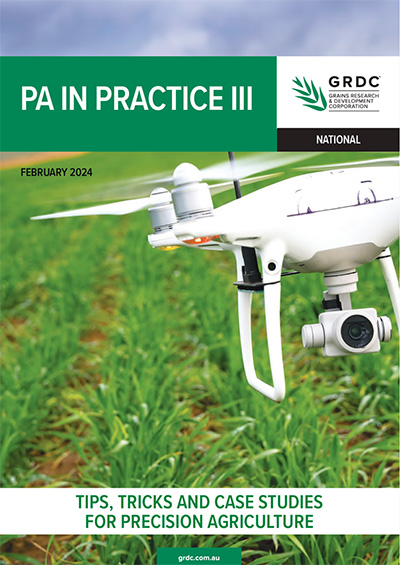Australian grain growers will benefit from new insights into precision agriculture (PA) for the grains industry with the release of the manual.
The publication was launched by Grains Research and Development Corporation (GRDC) Western Panel chair Darrin Lee today (February 26) at the Grains Research Update in Perth.
Produced by the Society of Precision Agriculture Australia (SPAA) with GRDC investment, the manual is part of the project precision fertiliser decisions in a tight economic climate.
Mr Lee says Australian growers were eager to implement PA into their farming practices, and for many the goal was limiting per hectare fertiliser usage while maintaining crop yields.
“Through our ³Ô¹ÏÍøÕ¾ Grower Network (NGN) and grower feedback mechanisms, GRDC has identified grower demand for education and extension to optimise the outcomes of PA adoption,” Mr Lee says.
“Growers want to know the questions they should be asking suppliers, agronomists, and consultants. They want to be aware of potential challenges and have the chance to listen to other growers’ success stories and advice.”
Mr Lee says a 2021 grower survey by SPAA and GRDC indicated that more than 50% of respondents wanted to use precision agriculture to make planting and fertilising decisions based on more data.
“Through the updated PA in Practice manual, growers have access to over 100 pages of content detailing PA throughout the season: pre-sowing, sowing, in-crop and at harvest. In addition, comprehensive case studies facilitate peer-to-peer learning and make the information easy to digest for growers.”
 In partnership with GRDC, SPAA has released the updated PA in Practice III with new insights into precision agriculture for the grains industry. Photo: GRDC
In partnership with GRDC, SPAA has released the updated PA in Practice III with new insights into precision agriculture for the grains industry. Photo: GRDC
SPAA Executive Offer Angelique McAvoy says the manual catered to all grain producers, agronomists or advisers regardless of their knowledge of PA.
“PA in Practice has been designed as a comprehensive foundational manual that clarifies definitions and provides step-by-step guides to applying PA such as remote sensing imagery, interpreting yield data, developing strip trials, or what to consider when choosing a new PA platform,” Ms McAvoy says.
“Complementing each chapter are 18 case studies from grain growers across Australia, providing relatable and regional perspectives. The generosity of all those who have contributed their knowledge and thought leadership to produce the content of PA in Practice III is greatly commended.”
Ms McAvoy acknowledged the publication’s author Alisa Bryce for her pivotal role in simplifying technical content and creating a valuable resource for a broad agricultural audience.
“PA in Practice will remain a vital SPAA educational resource that will be integrated into webinars and other learning platforms. It will play a key role in bridging knowledge gaps and addressing barriers to the adoption of PA,” Ms McAvoy says.
The manual’s release complements a national series of seven SPAA variable rate technology workshops supported by GRDC investment and delivered in 2023, which provided training to support growers’ fertiliser decision making, particularly with rising input costs.
The publication is available on the .






